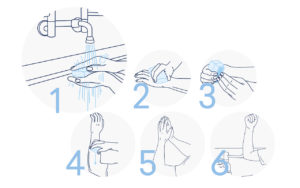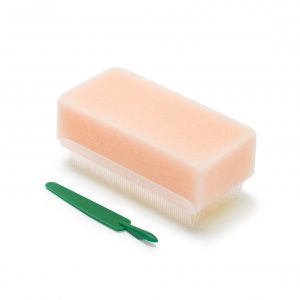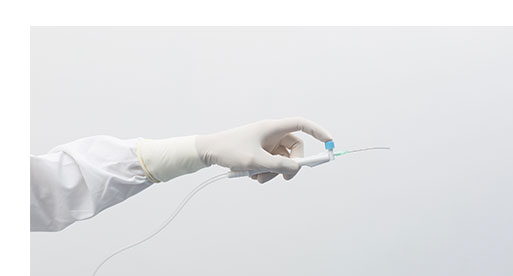The importance of washing your hands with a surgical scrub brush
The steps you need to follow
Hands are the easiest way to transmit germs, a small percentage of which are harmless, non-pathogenic micro-organisms usually found on human skin. Other types of germs found in the air and on surfaces, such as viruses and bacteria, are responsible for many diseases, from more frequent and less serious ones—like colds—to those that are more serious. Some germs survive for hours on surfaces and can enter your eyes, nose and mouth via your hands.
Therefore, keeping your hands clean is essential for the prevention of infections, both in social life and in healthcare settings, such as hospitals, clinics and dental practices.
Due to the Coronavirus crisis we are currently experiencing, we need to look more closely at this good hygiene practice to prevent contagion and limit the risk of Covid-19 spreading now and in the future. Hand washing is universally considered a fundamental precautionary measure for the prevention of infections.
The 5 key moments for hand washing
In healthcare settings, hands must be washed at the 5 key moments defined by the World Health Organization
1. Before touching a patient
You must wash your hands before touching a patient, even for standard contact like approaching them or shaking hands
2. Before an aseptic procedure
Using a surgical scrub brush if possible, you must wash your hands just before carrying out any aseptic procedure, e.g. dental cleaning where there is non-intact skin.
3. After exposure to body fluid or bioaerosol
You must clean your hands (after removing gloves) immediately after potential exposure to bodily fluids or bioaerosol, e.g. after contact with mucous membranes or non-intact skin or after carrying out dental cleaning.
4. After touching a patient
After touching a patient or being in close proximity to a patient
5. After touching patient surroundings
After touching any object or item of furniture in the immediate vicinity of the patient, even if the patient has not come into direct contact with it.
Washing hands before an aseptic procedure
Surgical antisepsis of the hands and forearms involves washing thoroughly with antiseptic soap. This is done by all members of the surgery team in direct contact with the aseptic surgical field, in order to reduce bacterial load and transient flora.
For maximum accuracy, the operator must ensure the following before washing their hands (CDC 2002/II, WHO 2006/II):
- Nails are cut short, less than 0.5 cm in length;
- Various jewellery and accessories, such as watches and rings, are removed as they may harbour micro-organisms capable of contaminating a body with pathogens (CDC 2002/II, WHO 2006/II);
This procedure must be carried out before any basic or highly invasive surgery procedure and at the end of the working day.
Hand washing with surgical scrub brush

Guide for using a dry surgical scrub brush
There are different types of surgical-washing products on the market. Among the most common surgical scrubs are liquid antiseptic or foam soaps used in combination with water and dry surgical scrub brushes.
Here’s what to do if you use a dry surgical scrub brush:
- Wet your hands and forearms up to the elbow joint;
- Avoid touching the dispenser lever if there is no protective film, and use your elbow to dispense the antiseptic soap;
- Carry out the surgical scrub and wash your hands and forearms for a few minutes under running water;
- Rinse your hands first and then your forearms while keeping your hands above your forearms to prevent water from leaking onto your hands;
- Carefully clean spaces under your nails with a file;
- Brush nails and cuticles, paying close attention to the areas between your fingers using a dry surgical scrub brush soaked in the antiseptic solution;
- Finally, drop the brush and file into a designated bin and rinse your hands first, followed by your forearms (keeping your hands above your forearms);
- Dry your hands and forearms with a sterile drape, starting with your fingers (one at a time), then the palm/back, wrist and finally the forearms up to the elbow joint.

Guide for using a surgical scrub brush with chlorhexidine
On the market, there are also sponges and surgical brushes preloaded with chlorhexidine, iodophor or PCMX (chloroxylenol). These are water-based products that do not require antiseptic soap to be added.
Here are the steps to follow when using a surgical scrub brush with chlorhexidine:
- Using water, wet your hands and forearms up to the elbows. Your hands must be held above the elbows at all times;
- Clean your nails with the file found inside your surgical scrub brush box;
- Use the sponge to rub your hands and forearms. To get the foam, you need to wet the sponge and wring it out.
- Only use the brush to rub your nails, cuticles and the areas between your fingers.
- Finally, drop the brush and file into a designated bin and rinse your hands first, followed by your forearms (keeping your hands above your forearms);
- Dry your hands and forearms with a sterile drape, starting with your fingers (one at a time), then the palm/back, wrist and finally the forearms up to the elbow joint





